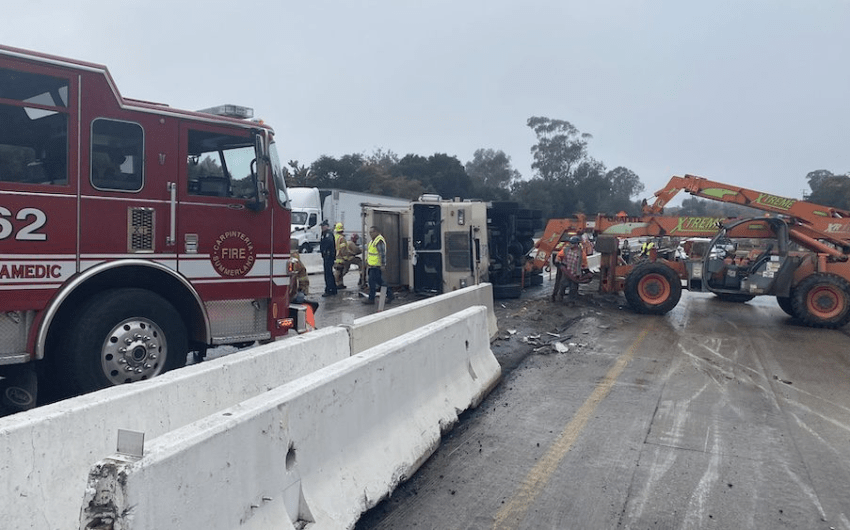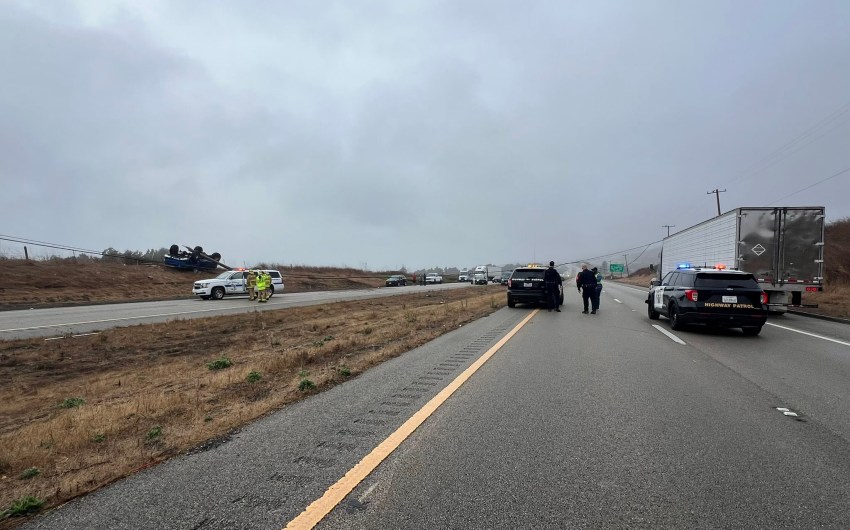Full Belly Files | Solving a Grape Mystery in Goleta
Sign up to get Matt Kettmann’s Full Belly Files, which serves up multiple courses of food & drink coverage every Friday, going off-menu from our regularly published content to deliver tasty nuggets of restaurant, recipe, and refreshment wisdom to your inbox

A few weeks ago, I was in the backyard of my buddy Diamond Dave’s house, watching him build a new two-story hutch for a desert tortoise his family had just adopted. As people in backyards do, we started talking about his various fruit trees, and he reminded me of the old grapevine on the side of his house.
Minutes later, I was picking off some of the season’s last grapes, taking photos of their mottled skins and the vine’s unique leaves. Though a touch russetted, they were still pretty green (rather than gold or red), with a thicker skin. When I popped them in my mouth, they sported a pleasing sweet-sour combination, with more aromatic, slightly floral elements than I’d expect from the usual table grape. They didn’t remind me of any grape I’d ever had.
Knowing that Dave’s house is only about a half-mile as the crow flies from the ancient San Jose Winery — which made wine for the Santa Barbara Mission in the early 1800s (read my 2018 article here) — I started to wonder if these grapes might be something special. Could this vine somehow be a remnant of Santa Barbara’s first vineyard?
Sensing a mystery to solve — or at the very least, good fodder for a Full Belly Files — I sent some pictures to my friend Jeff Newton, who founded Coastal Vineyard Care in 1984 and has been the go-to guy for high-quality viticulture in Santa Barbara County ever since. He’s settling into a semi-retired state these days, but “Coastal,” as most people call it, remains the dominant vineyard management operation in the region.
Jeff was intrigued, and emailed my photos and the general quandary to viticultural experts all around the country. That meant for a brief few days — or, more likely, a brief few minutes of thought within those days — Diamond Dave’s unknown grapevine was the talk of the American ampelography town.
From Bruce Reisch at Cornell to renowned Virginia vineyard consultant Lucie Morton to Mark Chien, whose vineyard experience goes from Pennsylvania to Oregon to Long Island, questions and comments flew back and forth on email.
“It’s just an interesting situation with this old vine on the site of a historic winery,” wrote Chien, who loves a good detective story. “It would be neat to find out what it is.”

Morton requested that next year we get photos of the front and back of the leaves and of the growing tips, which are apparently a great way to determine which grape it is. She also wondered, “Do they taste muscatty?”
A couple weekends later, Jeff stopped by Dave’s house to sample the scraps. There was only one grape, and it was just semi-ripe. “While a bit fruity, it was not muscat,” wrote Jeff. “Still a mystery to me. The leaves had a very jagged leaf margin, unlike any of the vinifera varieties we work with in S.B. County. Identification is probably best done by DNA analysis, but that might be a bit expensive.”
Having earned the attention of these vine experts, I asked why such a quest like this is important in the grand scheme of things, or at least why it was of interest to them.
Chien referred to my Santa Barbara wine history story, pointing out that, like everywhere in the country, there’s a significant missing link in wine and grape culture that runs from about 1918 until the mid-20th century. “Prohibition just leaves such a large historical gap that it’s hard to find a thread to connect 1920s to 1960s,” he said. “But if you discover that this odd vine has historical significance, you may have found your connection between the past and the present.”
In discussing why visual identification is key, Jeff recalled three instances of mistaken grapes from his career. One was at Zaca Mesa, where he discovered in 2001 that the viognier and roussanne grapes had been misidentified. Based on what he could see, he sent them in for DNA testing to clarify that the roussanne was really viognier.

Something similar happened in the Valle de Guadalupe region of Baja California, when Jeff first tried their nebbiolo. “While the wine was very good, I was aware that the dark, full-bodied wine bore no resemblance to nebbiolo from Barolo/Barbaresco with its lighter color, high tannin, and acid,” said Jeff, who then noticed that the leaf shape was different from the nebbiolo he’d been growing at Stolpman Vineyards.
He asked a nursery rep he was traveling with to run a DNA test, and they did. “It turned out to be Lambrusca di Alesandria, another Piedmonte variety,” said Jeff. “Many growers in VdG now label the wine Nebbiolo de Baja!”

His third story is also from Baja, though a bit further south, where he met a grower that had an odd, unidentified variety. The fruit looked like the Mission variety, lightly pink in color, but with leaves that resembled those of American rootstock. He sent photos to Andy Walker at UC Davis. “He said he needed to DNA test it to be sure, but that he thought it was probably a cross in nature between the Mission variety and the local native variety Vitis girdiana!” said Jeff.

As these emails flurried about, Morton was up in the Finger Lakes region of New York, filming a documentary called Odyssey of Forbidden Wines: Exile and Return of American Grapes.
“The only way this movie is possible is because I am one of an alarmingly dwindling number of trained ampelographers left,” wrote Morton. “The ability to identify grapes by their leaves and phenotypical expressions is paramount. DNA is confirmatory and can show parentage. However, one needs live vines to accomplish this and a laboratory with databank access.”She was short on time, because she had to give two lectures that week in addition to the film shoot. Morton hoped both efforts would get more young people interested in grapevines. “While our film is about saving grapes from extinction, I need to work with the right young person to pass along my skills before I go extinct!” she said.
Given that this remains an unsolved mystery, we’ll pay even more attention next year and take more photos of the leaves and the shoot tips. We’re not quite sure if we want to pay for DNA testing at this point — though we have the direct contact of the USDA germplasm pro — so maybe next year’s crop will bear more insightful fruit.
Diamond Dave is taking it seriously, and already gave his bush a recent trim. “Given the vine will be even more famous soon,” he said, “I spruced it up and rigged a trellis for it between my orange and lemon trees.”

Mad Crush Book Is Back
I knew Sean Christopher Weir for a number of years through the San Luis Obispo County wine and beer scene before I ever knew he wrote a book about working his first harvest at Saucelito Canyon back in 1995. When his book, The Mad Crush: An Obscure California Vineyard and the Quest to Make One Great Wine, was finally published in 2015, I interviewed Sean and wrote this article called “The Wild Wine Harvest of ‘95.”
Now he’s released a second edition, which features 30 new pages as well as an afterword. It’s a great opportunity for those who didn’t catch The Mad Crush the first time around, and it’s full of Santa Barbara lore as well, specifically that Saucelito Canyon was founded by Mountain Road escapee Bill Greenough. (Yes, his bro is the famous waterman George Greenough.)
Sean timed the release to coincide with the 50th anniversary of when Greenough restored the abandoned vineyard back in 1974. It’s worth a read, and a great gift for any literate wine lovers on your Christmas list. Click here to learn more and buy a copy.
From Our Table

Here are some stories you may have missed:
- George Yatchisin reports on the reopening of The Harbor Restaurant, with a menu that never seems to end.
- George also fell on the swanky sword and attended the Santa Barbara Wine Auction to file this report.
- The proposal to put a 1 percent tax on all Santa Barbara wines sold here in order to may for marketing efforts is back, so I wrote this introductory story.
- Smoke taint concerns are swirling in Santa Barbara wine country in the wake of the Lake Fire. I tasted some bad wine and got some good comments for this story.
Premier Events
Sat, Nov 30
11:00 AM
Santa Barbara
Mosaic Makers Market – Small Business Saturday
Thu, Dec 05
5:00 PM
Santa Barbara
First Thursday at Art & Soul in the Funk Zone
Wed, Nov 27
7:00 PM
Santa Barbara
The Hansen Family Songfest!
Thu, Nov 28
1:00 PM
Santa Barbara
The Cruisery Open on Thanksgiving
Fri, Nov 29
3:30 PM
Buellton
A Cowboy Christmas 2024
Fri, Nov 29
7:30 PM
Santa Barbara
Friendsgiving Country Night Black Friday
Sat, Nov 30
1:00 PM
Santa Barbara
Grateful Gathering-Live Dead & Jerry@The Brewhouse
Sat, Nov 30
1:00 PM
Santa Barbara
1st annual Funk Fest
Sat, Nov 30
9:30 PM
Santa Barbara
Numbskull Presents: The Cure & More DJ Night
Sun, Dec 01
5:00 PM
Santa Barbara
Paseo Nuevo Tree Lighting Ceremony
Fri, Dec 13
12:00 PM
Santa Barbara
Gem Faire
Fri, Dec 13
7:00 PM
Santa Barbara
SBHS 2024 Annual Fall Dance Recital
Sat, Nov 30 11:00 AM
Santa Barbara
Mosaic Makers Market – Small Business Saturday
Thu, Dec 05 5:00 PM
Santa Barbara
First Thursday at Art & Soul in the Funk Zone
Wed, Nov 27 7:00 PM
Santa Barbara
The Hansen Family Songfest!
Thu, Nov 28 1:00 PM
Santa Barbara
The Cruisery Open on Thanksgiving
Fri, Nov 29 3:30 PM
Buellton
A Cowboy Christmas 2024
Fri, Nov 29 7:30 PM
Santa Barbara
Friendsgiving Country Night Black Friday
Sat, Nov 30 1:00 PM
Santa Barbara
Grateful Gathering-Live Dead & Jerry@The Brewhouse
Sat, Nov 30 1:00 PM
Santa Barbara
1st annual Funk Fest
Sat, Nov 30 9:30 PM
Santa Barbara
Numbskull Presents: The Cure & More DJ Night
Sun, Dec 01 5:00 PM
Santa Barbara
Paseo Nuevo Tree Lighting Ceremony
Fri, Dec 13 12:00 PM
Santa Barbara
Gem Faire
Fri, Dec 13 7:00 PM
Santa Barbara


























You must be logged in to post a comment.